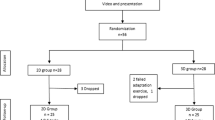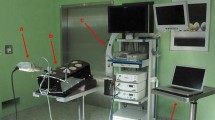Abstract
Background
Stereoscopic (3D) imaging can be used to facilitate the learning of basic laparoscopic tasks. Its advantages over traditional endoscopic (2D) imaging include better depth perception and spatial orientation. However, the transition between 3D and 2D imaging systems has not been previously studied. This study compares the acquisition of basic laparoscopic skills in a laparoscopic-naïve population using both imaging systems, and explores the possibility of a secondary learning curve in the transition between systems.
Methods
26 novice learners were randomly allocated into two arms and taught to perform two basic laparoscopic tasks adopted from the fundamentals of laparoscopic surgery (FLS) curriculum, peg transfer (T1) and pattern cutting (T2) using either 2D or 3D imaging systems. These tasks were repeated until proficiency was achieved. Participants in each arm then repeated the tasks in the other viewing system (2D/3D vs 3D/2D). The parameters measured were: (a) time taken to complete the task and (b) number of attempts to achieve proficiency.
Results
There was a significant shortening of time required to achieve proficiency in T2 using a 3D system (mean difference-in-differences = − 65.4, 95% CI − 103.6 to − 27.2, t(24) = − 3.5, p value = 0.002) but no difference between 2D and 3D imaging systems for T1, a simpler task. Sub-group analysis of T1 and T2 between the 2D/3D and 3D/2D arms showed the presence of a secondary learning curve in the 2D/3D arm for both tasks, (T1: β-estimate − 2.68, 95% CI − 3.68 to − 1.68, p value = 0.0003; T2: β-estimate − 2.45, 95% CI − 3.75 to − 1.14, p value 0.004), but in the 3D/2D arm there was a secondary learning curve only for T2. (β-estimate 2.60, 95% CI 1.45–3.76, p value 0.001)
Conclusion
3D imaging can be an effective tool to speed the acquisition of proficiency in basic laparoscopic tasks for novice learners, especially in more complex tasks such as pattern cutting. The skills learned in 3D imaging can translate into 2D, albeit with a secondary learning curve.
Similar content being viewed by others
References
Schoenthaler M, Schnell D, Wilhelm K, Schlager D, Adams F, Hein S, Wetterauer U, Miernik A (2016) Stereoscopic (3D) versus monoscopic (2D) laparoscopy: comparative study of performance using advanced HD optical systems in a surgical simulator model. World J Urol 34(4):471–477. https://doi.org/10.1007/s00345-015-1660-y
Özsoy M, Kallidonis P, Kyriazis I, Panagopoulos V, Vasilas M, Sakellaropoulos GC, Liatsikos E (2015) Novice surgeons: do they benefit from 3D laparoscopy? Lasers Med Sci 30(4):1325–1333. https://doi.org/10.1007/s10103-015-1739-0
Mashiach R, Mezhybovsky V, Nevler A, Gutman M, Ziv A, Khaikin M (2014) Three-dimensional imaging improves surgical skill performance in a laparoscopic test model for both experienced and novice laparoscopic surgeons. Surg Endosc 28(12):3489–3493. https://doi.org/10.1007/s00464-014-3635-2
Mistry M, Roach VA, Wilson TD (2013) Application of stereoscopic visualization on surgical skill acquisition in novices. J Surg Educ 70(5):563–570. https://doi.org/10.1016/j.jsurg.2013.04.006
Cologne KG, Zehetner J, Liwanag L, Cash C, Senagore AJ, Lipham JC (2015) Three-dimensional laparoscopy: does improved visualization decrease the learning curve among trainees in advanced procedures? Surg Laparosc Endosc Percutan Tech 25(4):321–323. https://doi.org/10.1097/SLE.0000000000000168
Sørensen SMD, Konge L, Bjerrum F (2017) 3D vision accelerates laparoscopic proficiency and skills are transferable to 2D conditions: a randomized trial. Am J Surg 214(1):63–68. https://doi.org/10.1016/j.amjsurg.2017.03.001
Zundel S, Lehnick D, Heyne-Pietschmann M, Trück M, Szavay P (2018) A suggestion on how to compare 2D and 3D laparoscopy: a qualitative analysis of the literature and randomized pilot study. J Laparoendosc Adv Surg Tech A 29(1):114–120. https://doi.org/10.1089/lap.2018.0164
Poudel S, Kurashima Y, Watanabe Y, Ebihara Y, Tamoto E, Murakami S, Nakamura T, Tsuchikawa T, Okamura K, Shichinohe T, Hirano S (2017) Impact of 3D in the training of basic laparoscopic skills and its transferability to 2D environment: a prospective randomized controlled trial. Surg Endosc 31(3):1111–1118. https://doi.org/10.1007/s00464-016-5074-8
de Almeida R, Qureshi Y, Morawala A, Merali N, Iloabachie I, Alaraimia B (2018) Patela B (2018) Impact of 3D laparoscopic surgical training on performance in standard 2D laparoscopic simulation: a randomised prospective study. J Surg Simul 5:1–7. https://doi.org/10.1102/2051-7726.2018.0001
Noureldin YA, Stoica A, Kaneva P, Andonian S (2016) Impact of training on three-dimensional versus two-dimensional laparoscopic systems on acquisition of laparoscopic skills in novices: a prospective comparative pilot study. Biomed Res Int 2016:4197693. https://doi.org/10.1155/2016/4197693
Roach VA, Mistry MR, Wilson TD (2014) Spatial visualization ability and laparoscopic skills in novice learners: evaluating stereoscopic versus monoscopic visualizations. Anat Sci Educ 7(4):295–301. https://doi.org/10.1002/ase.1412
Author information
Authors and Affiliations
Corresponding author
Ethics declarations
Disclosures
Dr. Kang, Mr Wong, Dr. Tan, Dr. Azri, Mr Han, and Dr. Soon have no conflicts of interest or financial ties to disclose.
Additional information
Publisher's Note
Springer Nature remains neutral with regard to jurisdictional claims in published maps and institutional affiliations.
Rights and permissions
About this article
Cite this article
Kang, M.L., Wong, C.M.J., Tan, H. et al. A secondary learning curve in 3D versus 2D imaging in laparoscopic training of surgical novices. Surg Endosc 35, 1046–1051 (2021). https://doi.org/10.1007/s00464-020-07466-y
Received:
Accepted:
Published:
Issue Date:
DOI: https://doi.org/10.1007/s00464-020-07466-y




